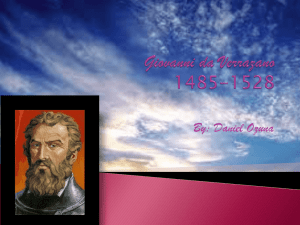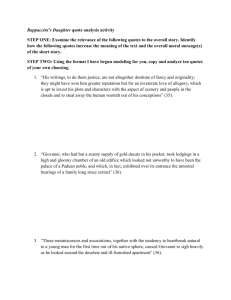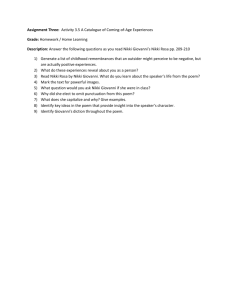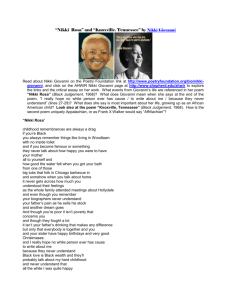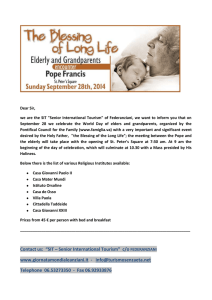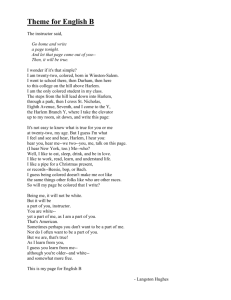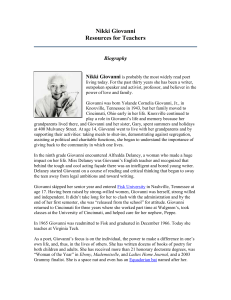Don Giovanni - Toledo Opera
advertisement
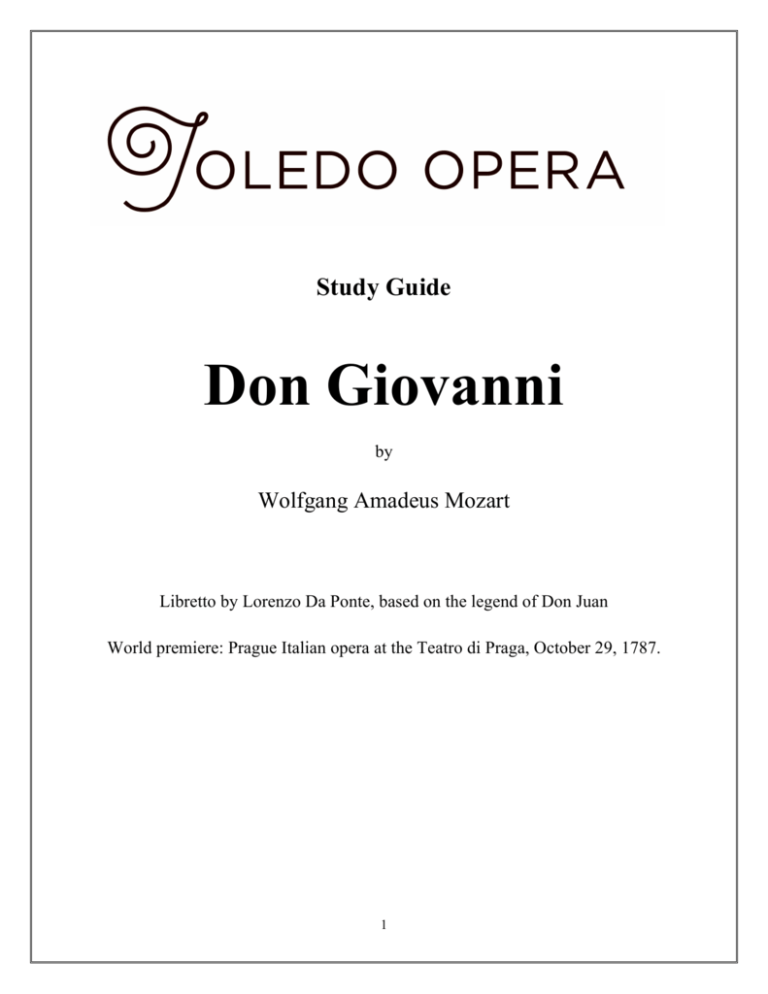
Study Guide Don Giovanni by Wolfgang Amadeus Mozart Libretto by Lorenzo Da Ponte, based on the legend of Don Juan World premiere: Prague Italian opera at the Teatro di Praga, October 29, 1787. 1 TABLE OF CONTENTS Guide to Characters in Don Giovanni……………………………………………………………..3 Who is Don Giovanni? The Legend of Don Juan……………………………….………………...4 Synopsis…………………………………………………………………………………………...5 About the Composer – Wolfgang Amadeus Mozart………………………………………………7 About the Librettist – Lorenzo Da Ponte………………………………………………………….9 Listen Up! Key Musical Moments in Don Giovanni…………………………………………….10 Student/Class Activities..........................................................................................................…...12 Test Your Opera Knowledge…………………………………………………………….13 Test Answers……………………………………………………………………..14 When & Where Does Don Giovanni Take Place?.............................................................15 Morals! Morals! Morals!....................................................................................................17 Tragedy or Comedy?..........................................................................................................17 Don Giovanni Crossword………………………………………………………………..18 Opera Word Search………………………………………………………………………19 Puzzle Answer Key………………………………………………………………20 2 Guide to Characters in Don Giovanni Don Giovanni (doh(n)-jaw-VAH(n)-nee): a young, amoral nobleman Voice type: baritone Leporello (leh-paw-REH(l)-law): Don Giovanni’s servant Voice type: bass Donna Anna (DOH(n)--nah AH(n)-nah): Il Commendatore’s daughter, betrothed to Don Ottavio Voice type: soprano Don Ottavio (doh(n)-aw(t)-TAH-vyaw): betrothed to Donna Anna Voice type: tenor Donna Elvira (DOH(n)--nah ehl-VEE-rah): a lady of Burgos abandoned by Don Giovanni Voice type: soprano Zerlina (dzehr-LEE-nah): Masetto's fiancée Voice type: soprano Masetto (mah-zay(t)-taw): a peasant Voice type: bass Il Commendatore (eel-koh(m)-mehn-dah-TOH-reh): also known as Don Pedro, Donna Anna’s father Voice type: bass 3 Who is Don Giovanni? The Legend of Don Juan The legend says that Don Juan either courted or seduced a young girl of noble family, and killed her father. Later, he came across a statue of the father in a cemetery and impiously invited it home to dine with him, an invitation which the statue gladly accepted. The ghost of the father arrived for dinner as the harbinger of Don Juan's death. The Statue asked to shake Don Juan's hand, and when he extended his arm, he was dragged away to Hell. In Hell, Don Juan was met by the Devil. The Devil informed him that everyone in Hell was cast in a role. The Devil then presented him with a Jester's suit -- "You'll make an excellent fool", he said. Don Juan is insulted by this, protesting that no other man was his equal, "I am the man who made a thousand conquests!" Intrigued by the claim, the Devil told him that if he could correctly name one of his conquests, he would not have to wear the suit. Thus the parade of women began, and not once could he name one correctly. Finally, one woman stands before him, tears on her face. Don Juan is moved. “Yes,” the Devil says, "this is the one woman who truly loved you." Don Juan looks into her eyes helplessly, then turns to the Devil and says, "Give me the suit." Most authorities agree that the first recorded tale of Don Juan is El burlador de Sevilla y convidado de piedra (The Trickster of Seville and Stone Guest) by Tirso de Molina. Its date of publication varies from source to source, ranging from 1620 to 1625, although it appeared in Spain as early as 1615. In it, Don Juan is an unrepentant womanizer who\ seduces women by disguising himself as their actual lovers, or by promising marriage. He leaves a trail of broken hearts and angry husbands and fathers behind him, finally slaying a certain Don Gonzalo. When later he is invited to dinner in the cathedral by Don Gonzalo's ghost, he accepts, not wanting to appear a coward. Depending upon the particular rendition of the legend, Don Juan's character may be presented in one of two perspectives, or somewhere in between. According to some, Don Juan was a simple, lustful womanizer, a cruel careless man who cares nothing for anyone but himself. Others, however, see Don Juan as a man who genuinely loves every woman he meets, and it is his gift to see the true beauty and intrinsic value which exist within every woman. The early versions of the legend always portray him in the former light. 4 Synopsis Don Giovanni by Wolfgang Amadeus Mozart Libretto by Lorenzo Da Ponte World premiere: Prague, National Theater (now Estates Theater), October 29, 1787 Act I Spain, mid-17th century*. Leporello, servant to the nobleman Don Giovanni, keeps watch outside the Commendatore’s home at night. Suddenly, the Commendatore’s daughter, Donna Anna, rushes out, struggling with the masked Giovanni and followed by her father. The Commendatore challenges Giovanni to a duel and is killed. Giovanni and Leporello escape. Anna asks her fiancé, Don Ottavio, to avenge her father’s death. In the morning, Giovanni and Leporello encounter one of Giovanni’s former conquests, Donna Elvira, who is devastated by his betrayal. Leporello tells her she is neither the first nor the last woman to fall victim to Giovanni and shows her his catalogue with the name of every woman Giovanni has seduced. Peasants celebrate the marriage of Masetto and Zerlina. Giovanni flirts with the bride, telling her she is destined for a better life. But Elvira tells Zerlina to flee her suitor. She also warns Anna, who is still unaware of the identity of her father’s murderer and has asked Giovanni for help in finding the man. Giovanni, for his part, insists that Elvira is mad, and Anna and Ottavio wonder what to believe. As Giovanni leaves, Anna suddenly recognizes his voice as that of the murderer. Devastated but determined, she once more asks Ottavio to avenge her. He wonders how to restore her peace of mind. Giovanni, who has invited the entire wedding party to his palace, looks forward to an evening of drinking and dancing. Outside Giovanni’s home, Zerlina asks Masetto to forgive her. Giovanni enters and leads them both inside. Anna, Elvira, and Ottavio appear masked and are invited in by Leporello. In the ballroom, Giovanni dances with Zerlina, then tries to drag her into the adjoining room. When she cries for help, Giovanni blames Leporello. Anna, Elvira, and Ottavio take off their masks and, along with Zerlina and Masetto, accuse Giovanni, who is momentarily surprised but manages to slip away. 5 Act II Having exchanged clothes with Giovanni, Leporello takes Elvira on a night-time walk, leaving his master free to serenade her maid. When Masetto arrives with a band of peasants to hunt down Giovanni, the disguised Don sends them off in various directions, then beats up Masetto. Zerlina finds her bruised fiancé and comforts him. Later that night, Leporello—still believed by Elvira to be Giovanni—is surprised by Anna, Ottavio, Zerlina, and Masetto, who all denounce the supposed Don. Fearing for his life, Leporello reveals his true identity before making his escape. Ottavio proclaims that he will take revenge on Giovanni and asks the others to look after Anna. Elvira thinks about Giovanni, whom she still loves in spite of everything. In a cemetery, Giovanni and Leporello meet the statue of the Commendatore, who warns Giovanni that by morning he will laugh no longer. Giovanni forces the terrified Leporello to invite the statue to dinner. The statue accepts. Once again, Ottavio asks Anna to marry him, but she replies that she will not until her father’s death has been avenged. Elvira arrives at Giovanni’s palace and makes a last desperate attempt to persuade him to change his life, but he only laughs at her. The figure of the Commendatore enters and asks Giovanni to repent. When he boldly refuses he is consumed by flames. Elvira, Anna, Ottavio, Zerlina, Masetto, and Leporello appear, contemplating their futures and the fate of an immoral man. Reprinted Courtesy of the Metropolitan Opera. *For information about Toledo Opera’s February 2013 production, please see the section of this guide called “When & Where Does Don Giovanni Take Place?” 6 About the Composer - Wolfgang Amadeus Mozart Wolfgang Amadeus Mozart was born January 27, 1756 in Salzburg, Austria, son of Leopold Mozart, a violinist and composer in the service of the Prince Archbishop. He started music lessons when he was three. By the time he was five years old, Mozart was already composing his own music and playing for empresses, electors and royal families. A child prodigy, Mozart was especially gifted in playing the piano, the harpsichord, and the organ, all the while composing for other instruments and vocal music. He was also fluent in Italian and French as well as his native German. There is no evidence of his formal schooling and it appears that his father was his tutor in all subjects. His father recognized his son’s exceptional talent and was determined to make him famous. A relatively poor family had much to gain financially with a child prodigy among its members. At the age of twelve Mozart had composed his first true opera, La finta semplice (The Pretended Simpleton). The singers refused to perform in a piece conducted by a little boy and there were accusations that the piece was written by his father, not the son. The theatre cancelled the contract and refused to pay Mozart his fee. During his teenage years, Mozart toured most of Europe, visiting Vienna once and Italy three times before returning home to Salzburg in 1774. In 1777, his parents thought it would be best for Mozart to find work elsewhere. Mozart and his mother moved to Munich, and then to Mannheim before settling in Paris. He returned to Salzburg in 1779 after the death of his mother. During this time, Mozart wrote many sonatas, operas, sacred works, symphonies, concertos, serenades and dramatic music. In 1781, the success of the opera seria, Idomeneo, prompted the young composer to take permanent residence in Vienna. Soon after his next operatic success, Die Entführung aus dem Serail (The Abduction from the Seraglio) in 1782, Mozart married a young woman by the name of Constanze Weber and they lived in Vienna for the rest of their lives. The couple would have six children, only two of whom survived infancy. Soon after, Mozart would meet Lorenzo Da Ponte with whom he would collaborate to create his three greatest operas: Le nozze di Figaro (The Marriage of Figaro), Don Giovanni and Così fan tutte. Mozart’s years in Vienna coincided with the reign of Emperor Joseph II (1780-1790). It was a period of enlightened reform throughout Europe, including Vienna. Censorship was largely abolished and tolerance laws for minorities were adopted. Joseph was a practical man. A childless bachelor, he kept a simple household. He dressed in plain clothing and thought of himself as the people’s emperor. Some reforms he imposed included censured funeral banquets, better training for physicians, increased availability of medical treatment, and protection of illegitimate children against discrimination. He also opened the royal hunting grounds as parks for the general public. Joseph was also a dedicated musician and practiced at least one hour a day. Mozart was one of the first self-employed musicians in Vienna. A typical day for Mozart during his early years in Vienna would entail arising at six, composing until nine or ten, giving lessons until about one, giving concerts in the evening, and then composing for a few more hours. He would sleep only five or six hours a night. The musical scene in Vienna was intense. Mozart was in demand as a guest artist and 7 accompanist. The public also continually craved new compositions, thus Mozart was constantly composing. He would often compose a whole piece in his mind before committing it to paper. He would also carry scraps of paper so he could jot down ideas at any time. Although he had a steady income from new works, ticket sales from concerts, royalties from publishers and fees from lessons, he did not know how to manage his money properly. Mozart and his wife spent lavishly. He dressed like nobility, as he felt his image was essential to his success. He also gave generously to his friends and charity. He never saved money and when emergencies occurred like the illness of wife Constanze, he had to borrow money. In 1791, Mozart died from a feverish illness. He had been working on a Requiem Mass that had been commissioned anonymously. Mozart became obsessed with the notion that the mass was for his funeral, but we now know that a Count Walsegg commissioned it. There are a few myths that surround the death of Mozart, some of which are perpetuated by the 1984 film Amadeus. The first myth is that Mozart was poisoned. The film and other sources imply that rival composer Antonio Salieri was involved in his death. This is completely untrue and was denied by Salieri on his deathbed. Recent research suggests that Mozart died of rheumatic fever, an illness he had suffered many times in the past. The second myth surrounding Mozart’s death is that he was buried in a pauper’s grave, forgotten by the rest of the world. Again, this myth is false. Mozart’s funeral was no different than most Viennese funerals of the time. Emperor Joseph II had issued a series of ordinances to cut down on the spread of disease and on ostentation. All cemeteries within the city limits were closed and new ones were opened a distance out of town. After the church ceremony the corpse would be carried without ceremony to the cemetery. To speed up the decomposition process no coffins were used. Bodies were placed in linen sacks placed in a grave with others, and covered with lime and earth. To save space no memorial stones were to be placed by the grave, but could be erected by the cemetery wall. This was the type of funeral that Mozart had. Mozart was not forgotten. His death was announced in many European papers and many members of the Viennese music community were at his funeral, though his wife, Constanze was too ill to attend. Mourners accompanied his body to the city gates, but few could afford a carriage for the long journey to the cemetery for the burial. Soon the funeral customs of this time changed and future generations unfamiliar with these customs inferred that Mozart had been buried as a pauper. In the end, it doesn’t matter how Mozart died. His music will live forever. Compiled from materials from the Cleveland Opera and San Diego Opera companies From Shakespeare and Swift I learned to write, but from Mozart I got my ideas. Mozart was the greatest of all musicians, He taught me how to say profound things and at the same time remain flippant and lively. George Bernard Shaw 8 About the Librettist - Lorenzo Da Ponte The librettist is the writer of the text or words in the opera. Lorenzo Da Ponte composed the words for three of Mozart’s operas: The Marriage of Figaro, Don Giovanni, and Così fan tutte. Born in 1749 in Italy, Da Ponte’s birth name was Emanuele Conegliano but, when his widowed father married a Roman Catholic and converted from Judaism to Catholicism, Da Ponte’s name was changed to that of the Bishop who baptized him, as was the custom of the time. Da Ponte started his varied careers as a priest then, after a few years, became a professor in Rhetoric. This also was a short-lived career, forced to end when Da Ponte was banned for teaching in the Venetian Republic after publishing some versed deemed highly subversive. That combined with his apparently scandalous personal life— he enjoyed gambling and women—caused him to be banished from Venice for 15 years. Da Ponte moved to Vienna in 1782. Fortunately for Da Ponte, the new emperor, Joseph II, preferred traditional Italian opera over the German singspiel (sung play). Da Ponte was named the new court theatre poet where he stayed busy composing librettos, working with the composer Salieri. A falling out with Salieri led Da Ponte to Salieri’s rival, Mozart. His work with Mozart remains among his best known. Eventually, Da Ponte’s lifestyle caused him to be banished from Vienna, as he was quite a Don Giovanni himself. Shortly after, he married, although technically he was still a priest. Although his financial struggles remained with him throughout his life, it appears that he was a faithful husband and father to their four children. After living in London during the early years of the 19th century, the Da Ponte family moved to the United States. Unable to live on his work as a poet and scholar, Da Ponte, along with his wife tried various ways to survive, including retail (owning a grocery store and later a book store), manufacturing (artificial flowers), and running a boarding house. In 1826, Da Ponte, with assistance from others, brought Italian opera to America, with the premiere of Don Giovanni in New York that May. In 1838, at 89 years of age, Da Ponte died. Ironically, he was buried in the same manner as the composer to whom he owed his lasting fame: in an unmarked, long forgotten grave. Compiled from materials from San Diego Opera and Cleveland Opera. 9 Listen up! Key Musical Moments in Don Giovanni Dramma vs. Giacoso Don Giovanni is known as a dramma giocoso, which means the opera contains elements of both drama and humor, sometimes simultaneously. The “dramma” moments have elements of the traditional opera seria, or serious and tragic opera to them, and the “giacoso” has elements of the opera buffa or comic opera of the time. Most of the characters fall neatly into one of the other category. Clearly Donna Anna, Don Ottavio, the Commendatore, and to a good extent, Donna Elvira, fall into the serious category, while Leporello and the two peasants, Zerlina and Masetto, are in the “buffa” category. That leaves Don Giovanni himself, about whom more has been written and said than almost any other operatic character of all time. He generally fits into whatever is going on at the time, occasionally acting as a serious contrast to Leporello’s comic character, and at other times playing the comedian as he sings a mock serenade to Donna Elvira’s maid. Except for his flashy but brief “Champagne Aria”, he has no real aria of his own, yet his presence permeates the entire opera, even when he is not physically present on the stage at the moment. Don Giovanni contains equal elements of seriousness and humor as he represents all of us. This makes his tragedy profound and makes us feel for him as we see that perhaps his actions are things we all might be capable of. Overture The Overture, in two distinct sections, emphasizes the contrast between serious and comic. The opening music of the overture foretells the climactic scene at the banquet when the statue comes to dinner. Two fortissimo, syncopated chords in the full orchestra, followed by deathly silence introduces the “dramma” portion of the opera. This is followed by syncopated melody in the violins with the pulses between the beats to increase the tension. All of this and more will return in the climactic scene near the end of the opera when the statue of the Commendatore accepts Don Giovanni’s offer to dine with him. The “dramma” portion of the Overture now stated, we come to the main body of the Overture, a bright, traditional “giocoso” feel, which to many represents the character of the impetuous, pleasure-seeking Don. Opening Scene Leporello is alone on stage while Don Giovanni is inside the palace trying to seduce the daughter of the Commendatore. In a light, staccato, comic aria, Leporello bemoans his lot as servant to the Don. Part of the style of an opera buffa is to have a comic bass sing lots of words in rapid fire patter style, often on one note (also called a patter-song). Donna Anna and Don Ottavio Don Ottavio is Donna Anna’s fiancé and has come to console her over the tragic death of her father. Their duet, completely in a minor key, reflects Donna Anna’s grief and Don Ottavio’s oath of revenge. Catalog Aria One of Mozart’s great comic arias is known as the “Catalog Aria.” As Don Giovanni has moved on to other adventures and conquests, he encounters a previous girlfriend. He runs away and leaves Leporello to explain why he deserted her. Leporello, in his “Catalog Aria,” recites a litany of the Don’s previous conquests: 640 (girls) in Italy, 231 in England, 100 in France; 91 in Turkey, and 1,003 in Spain. Running up and down the scale with rapid-fire precision , he describes the types of women Don Giovanni has seduced—Contessas, baronesses, Marchionesses, and Princess. By the end, he convinces Donna Elvira to get even with Don Giovanni. 10 Prayer Toward the end of Act I, Don Giovanni is giving a lavish party. Three uninvited masked guests appear— Donna Anna, Donna Elvira, and Don Ottavio. Not recognizing them, Don Giovanni invites them in. After a moment of hesitation, they decide to accept the invitation. But before they enter they offer a prayer for protection and vengeance. A powerfully dramatic moment, it is one of the most sublime utterances of prayer ever set to music. They sing a sort of round and Donna Anna’s voice soars ethereally as she unleashes her full emotions. Don Giovanni’s serenade Near the beginning of Act II, Don Giovanni sings a mock-serenade to Donna Elvira’s maid, “Deh Vieni alla finestra” (“please come to your window”). His exaggerated mannerisms and effusive words create a humorous scene. This aria is called a canzonetta (little song) and is accompanied by a mandolin with plucked strings. The End In the final scene, Don Giovanni is giving another one of his lavish banquets. A stage band plays some of the popular tunes of the day, including a quote from Mozart’s own Le Nozze di Figaro. At the height of the festivities a knock is heard at the door. It seems that the statue, which the Don had earlier invited to dinner, has, in fact, taken him up on his offer. Suddenly there is a crash of thunder, the lights grow dim, and powerful chords ring out. The music repeats the eeriness we heard in the Overture. The Commendatore calls out, “Don Giovanni, you have invited me to dinner and I have come!” It is one of the most chilling effects in all of opera as everyone shudders except Don Giovanni himself. He, in fact, nonchalantly orders Leporello to serve the statue supper. But the Commendatore does not take part in “earthly banquets” as he calls them. He has come for another purpose—to get the Don to repent! Leporello cowers under the table and the Statue becomes more intense. Finally the Don grasps his hand and cannot break its icy grip. Soon the gates of hell open as a fiery inferno beckons. A chorus of spirits from down below sing about the horror of the underworld, but it is too late. Don Giovanni is dragged down to the underworld accompanied by downward rushing minor scales. The music only turns light again when the Don is gone and the remaining players discuss the aftermath. Courtesy Chevron Texaco Opera Information Center 11 Student/Class Activities 12 Test Your Opera Knowledge To answer the following questions, refer to the information in this study guide and to articles found in the Learn: About Opera section of Toledo Opera’s website (www.toledoopera.org). General Opera 1. _______________________ A theatrical production incorporating both vocal and instrumental music, drama, and sometimes dance. 2. _________________________ The lowest male vocal range. 3. _______________________ An instrumental introduction to an opera. 4. _______________________ The area where the orchestra is seated. 5. _______________________ The song for solo voice in an opera. 6. _______________________ The highest female vocal range. 7. _______________________ A song for two voices. 8. _______________________ The Italian word meaning “little book” 9. _______________________ The middle male vocal range. 10. ______________________ A form of applause when shouted by members of the audience at the end of an especially pleasing performance. Don Giovanni 1. The opera was originally set in (the name of the country) ___________________ in the ___________ century. 2. __________________________wrote the libretto for Don Giovanni. 3. The composer of Don Giovanni is ____________________________. 4. The language in which Don Giovanni is written is _________________. 5. __________________________is a role for a baritone in Don Giovanni. 6. _________________________is Don Giovanni’s servant. 7. Don Giovanni is visited by the statue of ____________________at the end of the opera. 13 Test Answers General Opera 1. opera 2. bass 3. overture 4. orchestra pit 5. aria 6. soprano 7. duet 8. libretto 9. baritone 10. bravo, brava, or bravi Don Giovanni 1. Seville, Spain; 17th century 2. Lorenzo da Ponte 3. Wolfgang Amadeus Mozart 4. Italian 5. Don Giovanni and Masetto (both answers are correct) 6. Leporello 7. The Commendatore 14 When & Where Does Don Giovanni Take Place? Don Giovanni was first performed in 1787. Mozart set the opera in 17th century Seville, Spain; therefore, the costumes and scenery reflect that time and place. A production that is set as the composer originally intended is usually identified as traditional. Over the centuries since the opera was first produced, opera companies have continued to use a traditional setting. An example of this is the Los Angeles Opera’s fall 2012 production of Don Giovanni pictured below. Photo credit: Robert Millard for Los Angeles Opera 2012 However, especially in the 20th century, a number of directors and designers have set Don Giovanni in more contemporary times. One powerful example is the production directed by Peter Sellars, which takes place in Spanish Harlem, New York City. Sellars’ production was performed and recorded in Vienna in 1989 and telecast internationally in 1991 during the bicentennial of Mozart’s death. A portion of this production is available on YouTube.com at the following link: https://www.youtube.com/watch?v=25Kf-UmRTTE The reasons for breaking with the traditional set are many. Sometimes it is a response to budget concerns. Traditional productions, with elaborate sets and period costumes, are expensive to create or rent. More importantly perhaps, opera companies are often interested in providing a different lens through which audiences can view a great masterpiece such as Don Giovanni. After all, the themes and characters of this opera are universal and setting it in the twentieth century, for example, can encourage the audience to make connections with their own or a recent time period. Toledo Opera’s February 2013 production of Don Giovanni is set in Italy in the 1950s. The costumes and set have been rented from Boston Lyric Opera, who performed this production in 2009 (as seen in the two pictures below). The 1950s setting was originally created for Glimmerglass Opera, New York City Opera and Boston Lyric Opera by set designer Donald Eastman and costume designer Merrily Murray-Walsh. 15 Photo credit: Charles Erickson for Boston Lyric Opera 2009 Photo credit: Charles Erickson for Boston Lyric Opera 2009 Discussion Prompts 1. If you were reviewing Toledo Opera’s Don Giovanni, how would you describe the visual aspects of the production (i.e., scenery, lighting, costumes, props)? Would you give them a “thumbs up”? 2. If you were to design a production of Don Giovanni in a time period other than the traditional one (mid-17th century), what would it be and why? 16 Morals! Morals! Morals! Mozart and Da Ponte’s version of Don Giovanni is commonly identified as a “morality play.” Morality plays are a type of theatrical allegory in which the protagonist (leading character), who represents an aspect of human nature or an entire social class, is met by personifications of various moral attributes that try to prompt him to choose good over evil. Discussion Prompts 1. Is there a moral in Don Giovanni? If so, what is it? 2. If Don Giovanni were to represent one social group or way of living, what would it be? Think of modern-day examples. 3. Does Don Giovanni get what he deserves? Why? Tragedy or Comedy? Mozart’s Don Giovanni has been described as both noble and comic. This is evident in the blending of both farce and serious themes and characters in the opera. It is considered to be a masterpiece in large part because Mozart’s music expresses both comic and tragic elements, resulting in a wonderful balance between the two. In his chapter, “What Peter Sellars Did to Mozart”, critic David Littlejohn describes Mozart’s amazing achievement in Don Giovanni as follows: “He (Mozart) clearly delighted in broadly mixed, all-embracing genres; in breaking down altogether the walls between farce, laughing comedy, sentimental comedy, and tragedy. He relished the challenge of containing them all in resolved musical structures that demonstrate the moral and emotional complexity of human beings.” 1 Discussion Prompts 1. Can you think of a play, musical or movie that combines comedy and tragedy effectively? 2. What elements of the work provide the comedy and the tragedy? 3. In your view, does comedy or tragedy win out; or is a balance between the two achieved? 1 The Ultimate Art: Essays Around and About Opera. Littlejohn, David. Berkeley: University of California Press, p. 156. http://ark.cdlib.org/ark:/13030ft887008cv/ 17 Don Giovanni Crossword Refer to the information in this study guide. Across 1. What Don Giovanni likes 5. The statue is invited to this 6. Servant to Don Giovanni 7. Fiance of Donna Anna 8. The Commendatore is Donna Anna’s __________________ 9. Where Mozart wrote most of his masterpieces Down 2. Mad girlfriend of Don Giovanni 3. Librettist of Don Giovanni 4. Setting (or location) of the story 5. Spanish name for Don Giovanni 18 Opera Word Search Refer to the information in this study guide and to the articles found in the Learn: About Opera section of Toledo Opera’s website (www.toledoopera.org). Words can be up, down, forward, backward, or diagonal. Word Hints: Characters from Don Giovanni (8), Operatic Voice Types (6) M H VI I WP C E O J Y Y O K Y Z E B B J Z T UWU L J Q V F WT T X I Z Z I J MX D V B F E I K O L O O KB K E B B H C U E O Z Z X E E B F T R P P V R E D H A H L NC Y D L U X T U RZ G I T S N K D L Z Z WO L S H A D U N T U V I J R M L F F T D E Y U O E H J WA C J I D F J K I K C C L O G D A Y N EB N Z F F T E S L V F S Q N B L Q K V C ZD Y A J A J A X OO A P MQ I K I S B O O G A WC O Y J X HU T Q A E V N MRE H U C U R I J A P K Y U C MZ J L Q U L MV D E K K P L F H F V J O A D H R Z S X N V N Y S R WF E P U P D I B E Q Z B D J T V B A A L B K U WZ D N WX A C P S C U WC Y W Q S A A R ME H N C S J N K P F C Z U U D F OR R F H B F L G P O N A R P O S O Z Z E M S H WE A D D Y R D Q K WV N I T GV G K R T I Q G R O WP K A B K K N X B E Q V A H X E W X YA K D I U X P MX H E O E C A O C N K A L WA J P K I F E DWB D R I Z WB C A F I I WV WT S M S L R R G Q S D P Q OO K O Y T H Y O P WU L J H H U X WE WOU WN O Y Z Y L OE N T I Z R T F WF F K V E D B N Q K R OU H N G T S I WNI MG L C L R E M K L I R A V J C Z F N R S A A B K L K H I M L Z I A G T Z B B K O X S Z F A J F H OR L L O L X G OSS CXRODONOT T AVI ODDT J DI YI ODP R V U T N A T N Y V Z K I A E F R O R G O WA V S O C Z R F N O V HT N WL H Y A Y D U WZ E X H T N U L P AB K MP B N Q N J O E Y MH Q X N N D H C WE J R N E N Q UA H N I R J P X CM P S G Y N E O N J Y U V F P N A N H V YS D I R M C Z P OD Z R A Q M E D WI T U C L T N A O R U HS Z F D C J Z O I P J B N MWT E B C N I Z P N T N H F D QY Z S L D T C K S E A J O G U K S B A Y Z G O L D N Y C R RU K L Q S S Q I Z Z Q C E T T K X R G T H D R WX A H L Q DB G E K N A C Z Z WL WU F I N A I D H D WB K A C WY R KR I S G E R N C S I Q D O R G A Z O WY X X N A V U WO WT T Q J E WY 19 Puzzle Answer Key Crossword Across 1. Women 5. Dinner 6. Leporello 7. Ottavio 8. Father 9. Vienna Down 2. Elvira 3. Da Ponte 4. Seville 5. Don Juan Word Search Don Giovanni characters Don Giovanni Leporello Donna Anna Don Ottavio Donna Elvira Zerlina Masetto Il Commendatore Operatic voice types Bass Baritone Tenor Contralto Mezzo soprano Soprano 20
